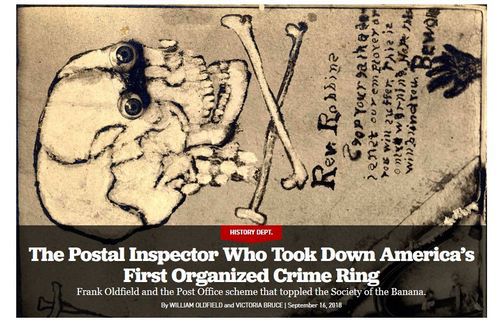


09/17/2018
It is well-known by students of organized crime and immigration that Italian immigration, particularly from Sicily and Naples, has not been an unmixed blessing. Here’s a story from Politico about the activities of the Black Hand in America in 1908:
On the night of April 18, 1908, in the railroad town of Bellefontaine, Ohio, about 50 miles northwest of Columbus, 18-year-old Charles Demar walked into the fruit shop he owned with his uncle, Salvatore Cira, and put a bullet into his uncle’s head. Salvatore’s body was discovered later that night by his wife among crates of bananas and apples spattered with his blood. When the police arrived, Mrs. Cira appeared not to understand them, or at least she pretended she didn’t speak English. This wasn’t unusual; the police commonly ran into this problem with Italian immigrants who wanted nothing to do with law enforcement on any level. The most preyed-upon victims were often unwilling to give police any leads, even if they’d personally seen a suspect commit a crime against a loved one.
It’s not that Bellefontaine police lacked investigative skills. No law enforcement institution in the nation had been able to penetrate the criminal organizations that had begun quietly terrorizing cities across America, particularly those with large populations of immigrants from Italy. Nearly 6 million Italian immigrants entered the country in the last two decades of the 1800s and organized crime, common in their native country, often found its way across the Atlantic, too. Increasingly in the papers, the gruesome crimes were credited to “Black Hand” criminals because of several recovered threat letters penned by “La Mano Nero” that demanded exorbitant payments, or death.
The Postal Inspector Who Took Down America’s First Organized Crime Ring
Frank Oldfield And The Post Office Scheme That Toppled The Society Of The Banana.
By William Oldfield And Victoria Bruce
September 16, 2018
Well, we all know that violent immigrants are a bad thing, and something should be done about it. In fact the 2016 election was fought on the question of violent immigrants — the Democrats were for them, and Trump was against them. (I wish I could say the Republicans were against them, but this is only reliably true if you mean Republican voters.)
Stories like this tend to concentrate on the immigrant victims, and consider the refusal of most Italian immigrants of the time to cooperate with the police in any way as somehow caused by American society.
Here’s a similar historical incident I blogged about in 2002:

William Bryk has an inspiring story in New York Press [November 20] about an immigrant policeman named Joe Petrosino, who fought the Mafia in its early days in New York. The reason Petrosino was so valuable to the NYPD was that there was indeed a huge Italian crime problem.
"In January 1905, Police Commissioner William McAdoo put Petrosino in charge of a five-man Italian squad. McAdoo’s successor, General Theodore Bingham, expanded the squad to 25 men, renaming it the Italian Legion and promoting Petrosino to lieutenant."
A squad like that wouldn’t be allowed today. Bryk continues:
"In 1907, Congress enacted a law permitting the deportation of any alien found to have concealed a criminal record. Two years later, Gen. Bingham secretly sent Petrosino to Italy with a list of 2000 names [of immigrants suspected of having criminal records there]."
The Mafia found out, and killed him.
It’s always heartwarming to hear of people coming to America, becoming citizens, and being loyal etc. etc. But immigration enthusiasts looking at the last Great Wave of immigration can only see the Petrosinos. They somehow miss the larger picture.
Guess what? There is still a huge Italian crime problem in New York. And there are now several other varieties of immigrant Mob, which are even worse.
Historan William Bryk has his columns archived at his own site now, so you can read about The Murder of Joe Petrosino, CityofSmoke.com. Petrosino’s grandnephew, Joseph A. Petrosino, is an assistant D. A. from Brooklyn, and his great-grandnephew, Joseph M. Petrosino is an officer with the NYPD.
But the Mafiosi who killed him have grandnephews too.